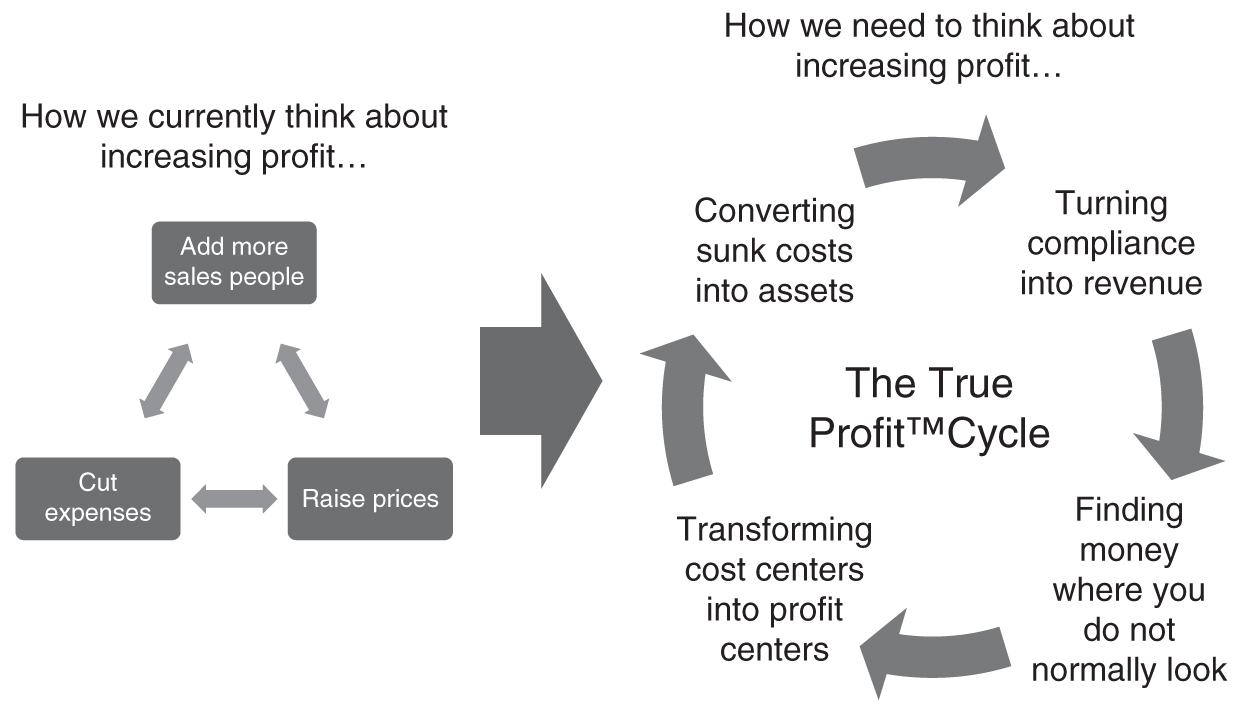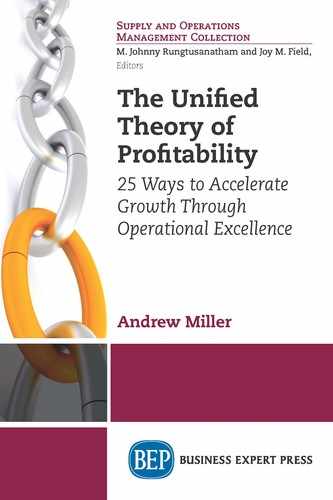Creating Your Hydraulic Profit Jack
I was speaking with a colleague a few months ago, telling her about the concept for this book. I mentioned that I had identified all these different ways to accelerate growth and increase profitability without making any new capital investment. She asked me about some of them, I told her some of my best ideas, and she replied, “You need some common or unified way of describing all of these different strategies because they are in so many different areas.” And that is how the Unified Theory of Profitability was born.
We need to change the way we think about accelerating growth and increasing profitability in our organizations. Many organizations still default to old ways of thinking—raising prices, continuously cutting costs, or adding new sales people as the only ways to increase revenues and profitability. But that leaves so much opportunity on the table.
We need to be able to better leverage the assets we already have, and turn compliance departments into revenue generators—cost centers into profit centers. We need to be able to find opportunities where we do not normally look. Figure 3.1 lays it out for us.

Figure 3.1 The unified theory of profitability
The Unified Theory of Profitability means we are able to turn sunk costs into assets. We can turn compliance into revenue (remember from Chapter 1 that compliance refers more to adherence with internal policies and procedures). We can find money where we do not normally look. And we can transform cost centers into profit centers.
The following are some specific examples of what I mean:
• Can you train your customer service representatives to offer customers new products and services once they have resolved a customer’s issue?
• Have you developed something for internal use that can be commercialized (an IT system or a tool)?
• Can you build stronger partnerships to increase value from your relationships with suppliers?
• Can you develop your account managers to focus on growth with their assigned customers instead of merely managing the account?
These are just a few examples of how to increase profitability without cutting costs or making any new capital investments.
Why Cost Centers Make No Sense
Currently, can any company afford to have a department or division that does not contribute to the top or bottom line? The concept of a cost center makes no sense. “Let’s develop a department where we incur costs and have no ties whatsoever to improve the overall financial performance of the organization. We will have no financial measures that help the overall company improve.”
So, here is where you say, “But not all departments can be tied directly to the financial performance of the overall organization!” Want to bet?
IT departments may have developed some great new technology tools to manage information in the company. Could not that be commercialized and sold?
Call center representatives, who talk to customers all day long, can be trained on all of your company’s offerings and help identify new customer needs that can be filled with those products and services.
Repair people and technicians can be trained to provide better solutions to customers while they are in the field. Procurement departments can negotiate better relationships with key suppliers. Finance departments can find more cost-effective ways to report on financial information.
In addition, any department can contribute new ideas to help with customer acquisition and retention, or revenue growth, or increasing profitability.
I think you get the point. Creating cost centers is an outdated idea that needs to become extinct. Are you one of the people giving it CPR to try to keep it alive?
The Unified Theory of Profitability encourages us to think of ways to raise revenues and profits by using less effort. Think of a jack for your car. Many of us have manual tire jacks in the trunk to be used in an emergency. Those jacks are slow and take a great deal of effort and time. Usually, we cannot afford that time and effort. So imagine a hydraulic jack, like the ones used in a repair shop. It is quick and easy to use, and requires minimal effort. That is what you need to create—a hydraulic jack for profit and growth. A way for you to grow profits and revenues quickly and with little effort. I am here to show you how to build a hydraulic profit jack.
25 Ways to Increase Profit and Accelerate Growth
The next 25 chapters lay out 25 different ways you can accelerate growth and increase profits in your organization without making any new capital investments. Those 25 strategies are broken up in to eight separate categories:
1. E Equals MC Squared (Chapters 4–7): Emotion equals customer continuance. The focus for this category is customers and how building an emotional connection will improve retention and growth with those customers. These four chapters provide you with strategies on how to grow using your current customer base, transitioning customers to higher margin products, and implementing new strategies to attract and retain your ideal customer better.
2. Maximizing Power at the Point of Attack (Chapters 8–11): These four chapters focus on employee engagement and empowerment on the frontlines. Your frontline employees are the ones who interact with customers all day long; so you need to ensure they are passionate about the organization and empowered to make decisions. These chapters focus on empowering frontline people, implementing strategy successfully across the organization, and setting expectations and measuring performance to maximize success.
3. Doing the High Jump, Not the Limbo (Chapters 12–15): These four chapters focus on your ideas of not only how to increase the quality of your ideas, but also how to become more innovative and opportunistic, identifying your best ideas, and maximizing the impact of those ideas. Innovation is not just about being creative and disruptive; it is also about capitalizing on and exploiting your best ideas.
4. Taking Procurement out of the Basement (Chapters 16 and 17): These chapters show how you can turn a compliance function into a revenue-generating one. Procurement is often considered a compliance function meant to use procedures to help organizations buy goods and services. These two chapters focus on how to leverage your procurement function to become better advisers to the organization to better leverage the assets you have already paid for, increase return on investment on purchasing dollars, and better manage relationships with suppliers and partners to increase profitability.
5. The TAO of Cost Minimization (Chapter 18): The focus of this chapter is looking at three key ways that your organization loses money and performance (Theft, Absenteeism, and Obsolescence) and identifies ways to minimize them in order to improve your bottom line.
6. Supply Chain Optimization (Chapters 19–22): These chapters focus on the supply chain—the manufacturing, movement, and storage of goods. The focus of these chapters is leveraging your supply chain to accelerate growth and increase profitability. In these chapters, I identify ways to profit from returns, defects and waste, leverage your supply chain to generate profits, reduce the number of touch points in your supply chain, and lower inventory by better anticipating customer demand.
7. Operational Excellence (Chapters 23–27): These four chapters focus on ways to accelerate growth and maximize profitability by pursuing excellence, not perfection. I discuss ways to find opportunities in areas you do not normally look, how to not over deliver on customer expectations, leveraging technology to achieve your strategic goals faster, and how to bring new customers on more quickly and effectively.
8. Your Market Crystal Ball (Chapter 28): The final chapter focuses on how to better assess and exploit new opportunities. Too many organizations pursue every opportunity that comes their way and it hurts their ability to grow quickly and successful. This chapter gives you strategies on how to identify those opportunities that can have the biggest impact.
You do not need to implement all 25 of these strategies, but there are enough of them that you also need to find one or two that will work for you.
How to Pick the Best Strategies
If you go back to the self-assessment from Chapter 1, you will have some ideas as to where the best opportunities lie. If you want a simpler way to determine which of the eight categories to focus on, try these questions:
• As you were reading the eight categories, which one of them resonated most? Which one did you say, “That is exactly the issue I need resolved?”
• Which category best covers opportunities/issues you hear about frequently in your organization?
• Which category affords the greatest opportunity to accelerate growth and/or increase profitability?
Inevitably, one or two of the categories stood out more than the others. Start with those. If you like, go right to those chapters and start reading. The goal of this book is to provide you with practical strategies that you can implement right away; so go find them.
